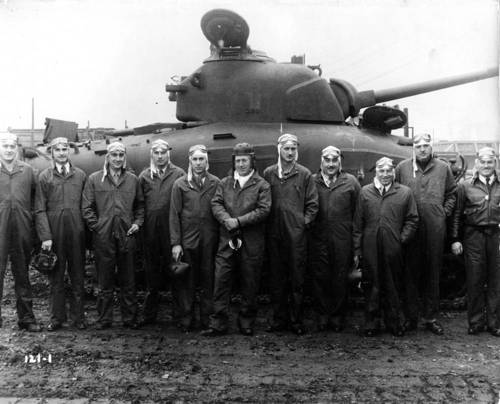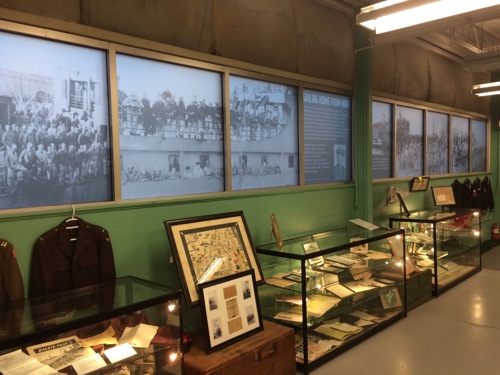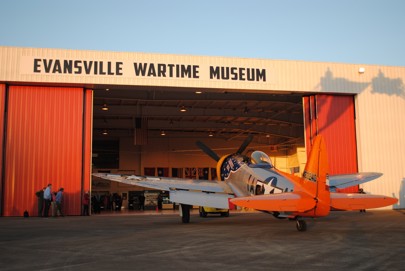
January 13, 2023
In early December 2022, Evansville earned a new distinction from the National Parks Service, designating the city as one of 18 American World War II Heritage Cities. The honor recognizes the tremendous amount of work of city industries and citizens as they produced Landing Ship Tanks (LSTs), P-47 airplanes, 96% of the .45-caliber ammunition in the U.S. over two years and other weaponry during the years of World War II.
Of course, many factors contributed to this distinction for Evansville, including the work of those involved with the Evansville Wartime Museum, located at 7503 Petersburg Road behind the Evansville Regional Airport. And within the Museum, two USI students were able to provide their talent and help bring recognition to the organization which honors Evansville and its residents during wartime.

Emily Green ’24, a Presidential Scholar and member of the USI Foundation Student Advisory Board, landed an internship at the Evansville Wartime Museum by chance. “It is a bit of a funny story. I wasn’t exactly looking for an internship at the time,” says the anthropology major. “I previously had considered a career in curation; I even looked at being an intern at the Evansville Museum at some point during my sophomore year.”
Working at the front desk of Rice Library over Spring Break in 2022 gave her the opportunity to meet with several members of the Wartime Museum. They were visiting the USI Archives Department, looking for intern candidates for the summer. Unfortunately, the archives were closed that day, but the connection Green was able to make that day led to an interview and accepting an internship. “I did a bit of everything at the museum. I learned how to do curation work, I also helped maintain the right conditions in the archives, which is another important part of curation,” she says. “But I also got to interact with the volunteers, help work the front desk, attend committee meetings and run special events.”
Some of Green’s favorite intern duties, however, came in the form of making exhibits in the museum. She was able to put her research skills to use, finding artifacts to fit the theme of her exhibit and arranging the display for visitors to view. She also was part of the five-year anniversary celebration of the museum and sat in a Sherman tank that was on exhibit. “No two days were the same there. It was so rewarding to be able to see how the museum operated behind the scenes,” says Green. “So much work went into the displays, and I learned so much from everyone.”

During her time at the Wartime Museum through the summer, Green says she learned valuable academic and career skills, but also the value of the relationships she formed with the volunteers who run the museum. “So many people put their hearts into their work at the museum. Their dedication inspired me in ways I can only begin to describe,” she says. “They wanted to get me involved and help me learn. They were some of the most genuine people I’ve met, and I miss them greatly.”
And naturally, Green worked to tell others about the museum and what it provided the community; something she continues to talk about. “When I told people I was interning at the Wartime Museum, they didn’t even know it existed!” she says. “More people need to know about the museum because visiting is such an incredible experience.”
In Flight
Leo Osborne ’24, a manufacturing engineering major, became connected with the Wartime Museum through the Center for Applied Research (CAR), which helps connect the University’s resources and knowledge with organizations in the community. The Wartime Museum contacted CAR about constructing a few exhibits for the museum. The department invited representatives from the museum to campus for a brainstorming session with some USI engineering professors and students, including Osborne. By the end of the meeting, the group had formed an idea for an exhibit to complement the existing top-of-the-line flight simulators at the museum.
“This project is exactly the kind of thing I was most looking forward to in college, something where I could gain hands-on experience outside of the classroom,” says Osborne. “Currently, I am the lead on this project as well as a few others including designing the packaging for a customer product that he originally prototyped through CAR.”
For the exhibit at the Wartime Museum, Osborne and his team were tasked with teaching people how a plane works with respect to the mechanical motion of the various flaps and how they affect the plane in the air. “The exhibit works by maneuvering the plane around with computer-controlled motors as well as motors inside of the plane that moves the flaps up and down,” he explains. “Those motors are connected to an old video game controller originally used for a flying game but designed to stand up to some wear and tear, an important quality for an exhibit of this nature.”

The project came with its challenges and opportunities, according to Osborne. Working on the exhibit allowed him a chance to work with programming, wiring and designing systems which he would not normally get experience with as a manufacturing engineer. This also meant reaching out to professors on campus for guidance, who Osborne said were more than happy to work with him to further the project. “Dr. Todd Nelson was a huge help and I would not have been able to do it without him,” he says. “One of my favorite things with this project and working with CAR is that I get to crossover into many different disciplines of engineering and get the most out of the resources on campus and my college experience.”
“Not being from the area, this project has really taught me about the history of Evansville,” says the Memphis, Tennessee, native. “I wish everyone in Evansville knew about the great opportunity to learn about the history of this fantastic city at the Evansville Wartime Museum. I look forward to the day, hopefully soon, when we deliver it to the museum and get the opportunity to see people using it and maybe inspire the next generation to become pilots or get them interested in mechanics and engineering.”
If you have students searching for internships during their time at USI or know of a local employer in need of interns, connect them with USI Career Services and Internships. For students and organizations interested in partnering with the Center for Applied Research, reach out to Steven Stump, Assistant Director of CAR, at ststump@usi.edu.